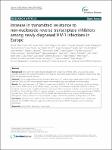Increase in transmitted resistance to non-nucleoside reverse transcriptase inhibitors among newly diagnosed HIV-1 infections in Europe
Frentz, Dineke
Vijver, David A. M. C. van de
Abecasis, Ana B.
Albert, Jan
Hamouda, Osamah
Jørgensen, Louise B.
Kücherer, Claudia
Struck, Daniel
Schmit, Jean-Claude
Vercauteren, Jurgen
Åsjö, Birgitta
Balotta, Claudia
Beshkov, Danail
Camacho, Ricardo J.
Clotet, Bonaventura
Coughlan, Suzie
Griskevicius, Algirdas
Grossman, Zehava
Horban, Andrzej
Kolupajeva, Tatjana
Korn, Klaus
Kostrikis, Leondios G.
Liitsola, Kirsi
Linka, Marek
Nielsen, Claus
Background: One out of ten newly diagnosed patients in Europe was infected with a virus carrying a drug resistant mutation. We analysed the patterns over time for transmitted drug resistance mutations (TDRM) using data from the European Spread program. Methods: Clinical, epidemiological and virological data from 4317 patients newly diagnosed with HIV-1 infection between 2002 and 2007 were analysed. Patients were enrolled using a pre-defined sampling strategy. Results: The overall prevalence of TDRM in this period was 8.9% (95% CI: 8.1-9.8). Interestingly, significant changes over time in TDRM caused by the different drug classes were found. Whereas nucleoside resistance mutations remained constant at 5%, a significant decline in protease inhibitors resistance mutations was observed, from 3.9% in 2002 to 1.6% in 2007 (p = 0.001). In contrast, resistance to non-nucleoside reverse transcriptase inhibitors (NNRTIs) doubled from 2.0% in 2002 to 4.1% in 2007 (p = 0.004) with 58% of viral strains carrying a K103N mutation. Phylogenetic analysis showed that these temporal changes could not be explained by large clusters of TDRM. Conclusion: During the years 2002 to 2007 transmitted resistance to NNRTI has doubled to 4% in Europe. The frequent use of NNRTI in first-line regimens and the clinical impact of NNRTI mutations warrants continued monitoring.
Dateien zu dieser Publikation
Keine Lizenzangabe

